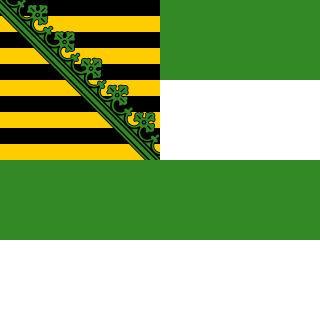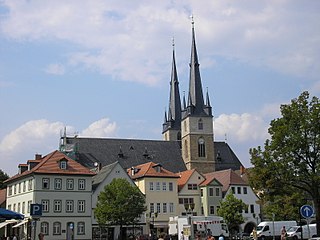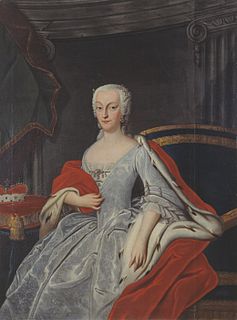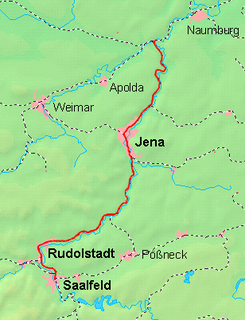
The Saale, also known as the Saxon Saale and Thuringian Saale, is a river in Germany and a left-bank tributary of the Elbe. It is not to be confused with the smaller Franconian Saale, a right-bank tributary of the Main, or the Saale in Lower Saxony, a tributary of the Leine.
Saalfeld-Rudolstadt is a Kreis (district) in the south of Thuringia, Germany. Neighboring districts are the districts Weimarer Land, Saale-Holzland, Saale-Orla, the district Kronach in Bavaria, and the districts Sonneberg, Hildburghausen and Ilm-Kreis.

Prince Frederick Josias of Saxe-Coburg-Saalfeld was an Austrian nobleman and military general.

Saxe-Meiningen was one of the Saxon duchies held by the Ernestine line of the Wettin dynasty, located in the southwest of the present-day German state of Thuringia.

The Battle of Saalfeld took place on 10 October 1806, at which a French force of 12,800 men commanded by Marshal Jean Lannes defeated a Prussian-Saxon force of 8,300 men under Prince Louis Ferdinand. The battle took place in Thuringia in what was the Ernestine duchy of Saxe-Coburg-Saalfeld. The battle was the second clash in the Prussian Campaign of the War of the Fourth Coalition.

Saalfeld is a town in Germany, capital of the Saalfeld-Rudolstadt district of Thuringia. It is best known internationally as the ancestral seat of the Saxe-Coburg and Gotha branch of the Saxon House of Wettin.

Saxe-Coburg-Saalfeld was one of the Saxon Duchies held by the Ernestine line of the Wettin Dynasty. Established in 1699, the Saxe-Coburg-Saalfield line lasted until the reshuffle of the Ernestine territories that occurred following the extinction of the Saxe-Gotha line in 1825, in which the Saxe-Coburg-Saalfeld line received Gotha, but lost Saalfeld to Saxe-Meiningen.

Francis Josias, Duke of Saxe-Coburg-Saalfeld was a duke of Saxe-Coburg-Saalfeld.

Princess Anna Sophie of Schwarzburg-Rudolstadt was a Princess of Schwarzburg-Rudolstadt.

Johann Ernest IV, Duke of Saxe-Coburg-Saalfeld was a reigning duke of Saxe-Coburg-Saalfeld.

Christian Ernst II, Duke of Saxe-Coburg-Saalfeld, was a duke of Saxe-Coburg-Saalfeld.

Ernest Frederick, Duke of Saxe-Coburg-Saalfeld, was a Duke of Saxe-Coburg-Saalfeld.

Francis, Duke of Saxe-Coburg-Saalfeld, was one of the ruling Thuringian dukes of the House of Wettin. As progenitor of a line of Coburg princes who, in the 19th and 20th centuries, ascended the thrones of several European realms, he is a patrilineal ancestor of the royal houses of Belgium, Bulgaria and Portugal, as well as of several queen consorts.

The Duchy of Saxe-Saalfeld was one of the Saxon Duchies held by the Ernestine line of the Wettin Dynasty. Established in 1680 for Johann Ernst, seventh son of Ernest I, Duke of Saxe-Gotha. It remained under this name until 1699, when Albert, Duke of Saxe-Coburg died without sons. His brother Johann Ernst of Saxe-Saalfeld became the new Duke of Coburg and the duchy was renamed into Saxe-Coburg-Saalfeld in 1735.

The Thuringian Highland, Thuringian Highlands or Thuringian-Vogtlandian Slate Mountains is a low range of mountains in the German state of Thuringia.

The Großheringen–Saalfeld railway, also known as the Saalbahn, is a 153 kilometre-long double-track main line in the German state of Thuringia. It connects the Thuringian Railway at Großheringen with the Franconian Forest Railway (Frankenwaldbahn) at Saalfeld and is part of the north-south main line, Munich–Nuremberg–Halle / Leipzig–Berlin. It is electrified at 15 kV. 16.7 Hz.

Saalfeld station is the station in the city of Saalfeld in the southeast of the German state of Thuringia. It is classified by Deutsche Bahn as a category 3 station.

A German tradition of decorating trees and bushes with Easter eggs is known as the Ostereierbaum, or Easter egg tree. A notable example is the Saalfelder Ostereierbaum in Saalfeld, Thuringia.

Charlotte Johanna of Waldeck-Wildungen was a daughter of Count Josias II of Waldeck-Wildungen and his wife, Wilhelmine Christine, a daughter of William of Nassau-Siegen.
Saalfeld-Rudolstadt II is an electoral constituency represented in the Landtag of Thuringia. It elects one member via first-past-the-post voting. Under the current constituency numbering system, it is designated as constituency 29 and It covers the eastern part of Saalfeld-Rudolstadt.




















